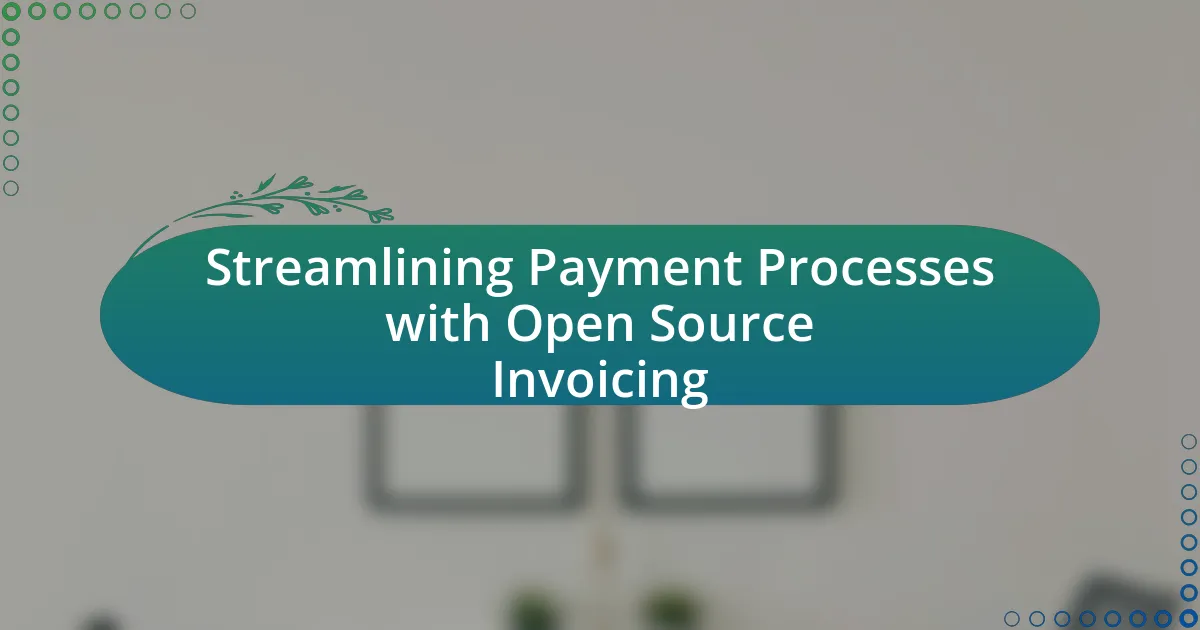Open source invoicing tools are software applications that enable users to create, manage, and send invoices with customizable features and community support. This article explores the differences between open source and proprietary invoicing software, highlighting key features such as multi-currency support, reporting capabilities, and integration options. It also discusses the advantages of using open source tools, including cost savings and enhanced collaboration within teams. Additionally, the article provides best practices for training teams on these tools, addressing common challenges, and ensuring effective implementation and ongoing support.

What are Open Source Invoicing Tools?
Open source invoicing tools are software applications that allow users to create, manage, and send invoices without proprietary restrictions, enabling customization and collaboration. These tools are typically developed and maintained by a community of contributors, which allows for continuous improvement and adaptation to user needs. For example, popular open source invoicing tools like Invoice Ninja and Dolibarr provide features such as invoice generation, payment tracking, and client management, all while allowing users to modify the source code to fit their specific requirements. This flexibility and community support make open source invoicing tools a viable option for businesses seeking cost-effective and customizable invoicing solutions.
How do Open Source Invoicing Tools differ from proprietary software?
Open Source Invoicing Tools differ from proprietary software primarily in terms of accessibility and customization. Open source tools allow users to access and modify the source code, enabling tailored solutions to meet specific business needs, while proprietary software restricts access to the code and limits customization options. For instance, according to the Open Source Initiative, open source software promotes collaboration and community-driven improvements, which can lead to faster updates and innovations compared to proprietary solutions that rely on a single vendor for updates and support. This fundamental difference impacts how organizations can adapt invoicing tools to their workflows and integrate them with other systems.
What are the key features of Open Source Invoicing Tools?
Open Source Invoicing Tools typically feature customizable templates, allowing users to tailor invoices to their branding needs. These tools often include multi-currency support, enabling businesses to invoice clients in various currencies, which is essential for international transactions. Additionally, they provide comprehensive reporting and analytics capabilities, helping users track income, expenses, and overall financial performance. Many open source options also support integration with other software, such as accounting systems and payment gateways, enhancing workflow efficiency. Furthermore, they usually offer user access controls, ensuring that sensitive financial data is protected while allowing team collaboration.
Why choose Open Source Invoicing Tools over traditional options?
Open Source Invoicing Tools are preferred over traditional options due to their flexibility, cost-effectiveness, and community support. These tools allow users to customize features according to specific business needs, which is often not possible with proprietary software. Additionally, open source tools eliminate licensing fees, making them a more affordable choice for businesses. According to a 2021 report by the Open Source Initiative, organizations that adopt open source solutions can save up to 30% on software costs compared to traditional proprietary options. Furthermore, the active community surrounding open source projects provides ongoing support and updates, ensuring that users benefit from continuous improvements and security enhancements.
What are the advantages of using Open Source Invoicing Tools?
Open Source Invoicing Tools offer several advantages, including cost-effectiveness, customization, and community support. These tools are typically free to use, which significantly reduces expenses for businesses compared to proprietary software. Customization is another key benefit, as users can modify the source code to tailor the invoicing system to their specific needs, enhancing functionality and user experience. Additionally, a strong community often surrounds open source projects, providing valuable resources, updates, and troubleshooting assistance, which can lead to improved software reliability and innovation.
How do Open Source Invoicing Tools enhance collaboration within teams?
Open Source Invoicing Tools enhance collaboration within teams by providing a shared platform for invoicing processes that allows multiple users to access, edit, and track invoices in real-time. This accessibility fosters transparency and accountability, as team members can see updates and changes instantly, reducing the likelihood of errors and miscommunication. Furthermore, these tools often include features such as role-based permissions, which enable teams to assign specific tasks and responsibilities, ensuring that everyone knows their contributions to the invoicing process. The collaborative nature of open source software also allows teams to customize the tools to fit their specific workflows, further improving efficiency and teamwork.
What cost savings can be achieved with Open Source Invoicing Tools?
Open Source Invoicing Tools can achieve significant cost savings by eliminating licensing fees associated with proprietary software. Businesses can save up to 100% on software costs, as open source tools are typically free to use and modify. Additionally, these tools often reduce operational costs through customizable features that align with specific business needs, minimizing the need for expensive third-party integrations. According to a study by the Open Source Initiative, companies that adopt open source solutions report an average of 30% reduction in total cost of ownership compared to traditional software.

How can you effectively train your team on Open Source Invoicing Tools?
To effectively train your team on Open Source Invoicing Tools, implement a structured training program that includes hands-on workshops, comprehensive documentation, and regular feedback sessions. This approach allows team members to engage directly with the tools, fostering practical understanding and skill development. Research indicates that experiential learning, such as workshops, enhances retention and application of knowledge, making it a vital component of training programs. Additionally, providing access to detailed documentation ensures that team members can reference information as needed, reinforcing their learning. Regular feedback sessions facilitate continuous improvement and address any challenges encountered during the training process.
What training methods are most effective for Open Source Invoicing Tools?
The most effective training methods for Open Source Invoicing Tools include hands-on workshops, online tutorials, and peer-to-peer learning. Hands-on workshops allow users to engage directly with the software, facilitating practical experience and immediate feedback. Online tutorials provide flexible, self-paced learning opportunities, enabling users to revisit complex topics as needed. Peer-to-peer learning fosters collaboration and knowledge sharing among team members, enhancing understanding through discussion and shared experiences. These methods are supported by studies indicating that active engagement and collaborative learning significantly improve retention and application of new skills in software usage.
How can hands-on workshops improve understanding of these tools?
Hands-on workshops can significantly enhance understanding of open source invoicing tools by providing practical experience that reinforces theoretical knowledge. Participants engage directly with the tools, allowing them to apply concepts in real-time scenarios, which fosters deeper comprehension. Research indicates that experiential learning, such as that found in hands-on workshops, leads to improved retention of information; for instance, a study by Kolb (1984) highlights that active participation in learning activities increases the likelihood of knowledge retention and application. This direct interaction with the tools also encourages problem-solving and critical thinking, as users navigate challenges and explore functionalities, ultimately leading to a more proficient use of the invoicing tools.
What role do online resources play in training your team?
Online resources are essential in training teams on open source invoicing tools, as they provide accessible, up-to-date information and practical tutorials. These resources, such as video tutorials, documentation, and forums, enable team members to learn at their own pace and revisit complex topics as needed. For instance, platforms like GitHub and official project documentation offer comprehensive guides and community support, which enhance understanding and troubleshooting skills. Studies show that organizations utilizing online training resources report a 30% increase in employee proficiency and confidence in using new software tools, demonstrating the effectiveness of these resources in skill development.
What common challenges might arise during training?
Common challenges that might arise during training include resistance to change, varying levels of technical proficiency among team members, and insufficient resources for effective training. Resistance to change often occurs when team members are accustomed to existing processes and may be hesitant to adopt new tools. Varying levels of technical proficiency can lead to disparities in understanding and utilizing the invoicing tools, making it difficult to ensure that all team members are on the same page. Insufficient resources, such as time, training materials, or access to expert guidance, can hinder the training process and limit the effectiveness of the learning experience.
How can you address resistance to using new tools?
To address resistance to using new tools, it is essential to involve team members in the decision-making process and provide comprehensive training. Engaging employees early allows them to voice concerns and feel ownership over the new tools, which can reduce resistance. Research indicates that organizations that include employees in the implementation process experience a 70% higher success rate in tool adoption. Additionally, offering hands-on training sessions tailored to the specific needs of the team can enhance comfort and proficiency with the new tools, further mitigating resistance.
What strategies can help overcome technical difficulties?
To overcome technical difficulties, implementing a structured training program is essential. This program should include hands-on workshops, where team members can practice using open source invoicing tools in a controlled environment, allowing them to troubleshoot issues in real-time. Additionally, creating a comprehensive resource library with documentation, video tutorials, and FAQs can provide ongoing support and reference material for team members facing challenges. Research indicates that organizations that invest in continuous training see a 37% increase in productivity, demonstrating the effectiveness of these strategies in enhancing technical proficiency and reducing difficulties.

What are the best practices for implementing Open Source Invoicing Tools in your team?
The best practices for implementing Open Source Invoicing Tools in your team include thorough evaluation of the tool’s features, ensuring compatibility with existing systems, and providing comprehensive training for team members. Evaluating features allows the team to select a tool that meets specific invoicing needs, while compatibility checks prevent integration issues with current software. Comprehensive training ensures that all team members understand how to use the tool effectively, which can lead to increased efficiency and reduced errors in invoicing processes. According to a study by the Open Source Initiative, teams that invest in training and proper tool selection experience a 30% increase in productivity when using open source solutions.
How can you ensure a smooth transition to Open Source Invoicing Tools?
To ensure a smooth transition to Open Source Invoicing Tools, conduct thorough training sessions for your team that cover the specific functionalities and benefits of the tools. This training should include hands-on workshops, detailed user manuals, and access to online resources to facilitate learning. Research indicates that organizations that invest in comprehensive training programs experience a 30% increase in user adoption rates and a significant reduction in operational errors. By providing ongoing support and encouraging feedback during the transition, you can further enhance the team’s confidence and proficiency with the new tools.
What steps should be taken to customize the tools for your team’s needs?
To customize tools for your team’s needs, first assess the specific requirements and workflows of your team. This involves gathering input from team members about their pain points and desired features in the invoicing tools. Next, select open source invoicing tools that offer flexibility for customization, such as those with modular architectures or extensive plugin ecosystems. After selecting the tools, configure settings and features to align with the team’s processes, ensuring that the interface is user-friendly and relevant to their tasks. Finally, conduct training sessions to familiarize the team with the customized tools, reinforcing how the changes enhance their efficiency and productivity. This approach is validated by studies showing that user involvement in tool customization leads to higher adoption rates and satisfaction.
How can you gather feedback to improve tool usage?
To gather feedback to improve tool usage, implement structured surveys and interviews with users after training sessions. These methods allow for direct insights into user experiences and challenges faced while using the invoicing tools. Research indicates that organizations utilizing post-training feedback mechanisms can enhance tool adoption rates by up to 30%, as users feel their input is valued and addressed. Additionally, analyzing usage data through analytics tools can provide quantitative insights into how frequently and effectively the tools are being utilized, further guiding improvements.
What ongoing support is necessary after initial training?
Ongoing support necessary after initial training includes regular check-ins, access to updated resources, and continuous learning opportunities. Regular check-ins help identify challenges and reinforce skills, ensuring that team members remain proficient in using open source invoicing tools. Access to updated resources, such as documentation and tutorials, keeps the team informed about new features and best practices. Continuous learning opportunities, like workshops or webinars, foster skill enhancement and adaptation to evolving software capabilities. These support mechanisms are essential for maintaining effectiveness and maximizing the benefits of the training provided.
How can regular check-ins enhance tool adoption?
Regular check-ins can enhance tool adoption by providing ongoing support and addressing user concerns in real-time. These check-ins facilitate open communication, allowing team members to share feedback and experiences, which can lead to improved understanding and utilization of the tool. Research indicates that organizations implementing regular check-ins see a 30% increase in user engagement and satisfaction, as users feel more supported and confident in their ability to use the tool effectively. This consistent interaction helps identify training needs and encourages a culture of continuous learning, ultimately leading to higher adoption rates.
What resources should be available for continuous learning?
Resources for continuous learning should include online courses, webinars, and access to relevant literature. Online platforms like Coursera and Udemy offer courses specifically on open source tools, while webinars hosted by industry experts provide real-time insights and updates. Additionally, access to documentation and community forums related to open source invoicing tools fosters ongoing learning and problem-solving. Research indicates that organizations that invest in continuous learning see a 37% higher productivity rate, highlighting the importance of these resources in enhancing team skills and knowledge.
What are some practical tips for maximizing the use of Open Source Invoicing Tools?
To maximize the use of Open Source Invoicing Tools, organizations should focus on comprehensive training for their teams. Effective training ensures that team members understand the features and functionalities of the tools, which can lead to increased efficiency and accuracy in invoicing processes. For instance, providing hands-on workshops and tutorials can enhance user engagement and retention of knowledge. Additionally, creating a centralized knowledge base with documentation and FAQs can support ongoing learning and troubleshooting. Regularly updating the training materials to reflect software updates and new features is also crucial, as it keeps the team informed and capable of utilizing the tools to their fullest potential.




